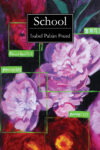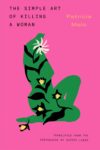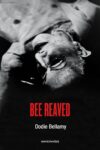The following is from the latest issue of the Full Stop Quarterly. You can purchase the issue here or subscribe at our Patreon page.
In 1994, thirty-two years after winning the Nobel Prize for his research on the structure of DNA, Francis Crick published The Astonishing Hypothesis: The Scientific Search for the Soul, which begins:
“You,” your joys and your sorrows, your memories and your ambitions, your sense of personal identity and free will, are in fact no more than the behavior of a vast assembly of nerve cells and their associated molecules.
Crick hoped this provocation, along with his Nobel credibility, would stimulate interest in a dormant area of research, the neural correlates of consciousness. And though, as Crick would warn us, correlation does not imply causation, it seems he succeeded. With the help of functional magnetic resonance imaging (fMRI), the following decades witnessed an explosion of activity in the area as researchers raced to close the “explanatory gap” between brain activity and experience. But with more than 100,000 fMRI studies published in less than thirty years, some neuroscientists have begun to wonder if the field, in which funding is often reserved for questions with predictable answers, has traded theory testing for mindless data collecting.
If neuroscientists have begun to question their approach, you wouldn’t know it from the litany of popular science books on the subject. Indeed, this may be another legacy of Crick, with barely a year passing without the arrival of a new jargon-defining, metaphor-filled bestseller about the brain. This year there’s Daniel Levitin’s Successful Aging: A Neuroscientist Explores the Power and Potential of Our Lives, which promises to “revolutionize the way we plan for old age.” Last year there was Annaka Harris’s Conscious: A Brief Guide to the Fundamental Mystery of the Mind, which cites neural correlates to argue against free will. Other recent titles (and subtitles) include Incognito: The Secret Lives of the Brain, How Emotions Are Made: The Secret Life of the Brain, and The Secret Life of the Mind: How Your Brain Thinks, Feels, and Decides, all of them claiming to decode the esoteric science of us.
The belief that we can explain how the brain produces consciousness is not universal. Mysterian psychologists from William James and Carl Jung to Steven Pinker and Colin McGinn have suggested that we may be no more equipped to solve the “hard problem” of consciousness than we are to see ultraviolet light. Meanwhile, some philosophers have argued that the hard problem can’t be solved because it doesn’t exist. According to Richard Rorty, the line between mind and body has been drawn, when it has been drawn at all, in different places at different times, and only recently did philosophers begin to mistake the line for something real enough to pose a problem. But if the hard problem was once just a symptom of having a philosophy degree, it has since spread. And though many popular science books could just as easily be classified as self-help, books like Charles Murray’s new Human Diversity, which invokes neuroscience and genetics to argue for the innateness of various gender, race, and class stereotypes, show just what is at stake when science, even dubious science, feels too close for comfort.
Yet the explanatory gap does not have to be a source of problems alone. Spaces like this—whether between the body and the mind, the self and the other, or the nameable and the unnameable—rather than holes to be closed or avoided, can also be sources of identity, meaning, and change. And two recent books, Michael Pollan’s 2018 bestseller How to Change Your Mind and SJ Fowler’s 2020 I will show you the life of the mind (on prescription drugs), test the boundaries of popular science to show that the space between the explicable and the inexplicable can be a site of healing and creativity.
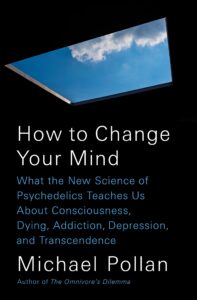
In How to Change Your Mind, Michael Pollan, author of The Omnivore’s Dilemma, a copy of which you are never more than ten feet away from, examines the history, science, and recent reemergence of psychedelic therapy. Despite being forced underground in the 1960s, psychedelics, which have a long history of use in healing and religious practices, have shown extraordinary promise as treatments for addiction, depression, and the “existential distress” that can accompany terminal diagnoses. While many recent mental health treatments have been aimed at either the body or the mind alone, Pollan says, psychedelic therapy, which involves both a drug and an ordeal, “may have the power to change how we experience our personal history and environment, no matter how impoverished or painful they may be.”
Neuroscientist Robin Carhart-Harris tells Pollan that psychedelics accomplish this by disrupting our default mode network, the usual pattern of brain activity that, when overactive, can lead to rigid habits and depressing rumination. Given the writer’s other books, however, it comes as no surprise when Pollan, who practices hunting and gathering in The Omnivore’s Dilemma and abstains from coffee and tea in Caffeine (released earlier this year), decides to experience and explain the effects for himself. But while Pollan’s mild doses of LSD and psilocybin lead to familiar lessons about himself and his relationships, his intense experience with the venom of the Sonoran Desert toad, which one interviewee calls the “Everest of psychedelics,” leaves the prolific writer at a loss for words.
[T]here was no coherent thought, just pure and terrible sensation. . . . It lacked the beginning, middle, and end that all my previous trips had had and that we rely on to make sense of experience. That and its mind-bending velocity made it difficult to extract much information or knowledge from the journey, except for the (classic) psychedelic platitude about the importance of being.
Both the ineffable and the banal present problems for Pollan, not only as a writer but also as an advocate for psychedelic integration therapy, which assumes therapeutic effects require one to integrate the meanings of a trip into one’s life with the help of a professional (otherwise, Pollan says, it’s “simply a ‘drug experience’”). Yet Pollan isn’t the only person to find that the secret of the universe glimpsed during a trip becomes, once the drug wears off, little more than a platitude. Indeed, despite study volunteers frequently ranking their psychedelic experiences among the most meaningful events of their lives, this combination of ineffability and banality is common. One trial volunteer Pollan interviews compares the insights of his psilocybin-induced “cosmic vision” to those printed on Hallmark cards. Another who felt she was being “bathed in God’s love” during her trip nevertheless remains a “solid atheist.” “The insights I gained during the trial have never left me,” says yet another volunteer, back on Zoloft a year after his dose of psilocybin. “But they now feel more like ideas.”
Seeking solid ground, Pollan fills out the Revised Mystical Experience Questionnaire, which asks subjects to rate the degree to which they experienced things like “amazement,” “fusion of [their] personal self into a larger whole,” and “the insight that ‘all is One’” on a scale from zero to five (with five being the most One). The survey can be useful in experimental settings—subjects who score higher tend to experience more relief from symptoms of depression—but after scoring a sixty-one, one point over the cutoff for a “complete mystical experience,” Pollan, like many D students before him, finds himself dissatisfied with the metric. “Struggling to assign ratings,” Pollan says, “I felt the survey pulling me in the direction of a conclusion that was not at all consistent with what I felt.”
And so Pollan turns, as all popular science writers must, to metaphor. Recalling his toad trip, Pollan describes a “category 5 mental storm” that causes his ego to explode “like one of those flimsy wooden houses erected on Bikini Atoll” in the nuclear tests. Next, to convey the trip’s peak, Pollan offers two separate metaphors. In the first, the now-egoless Pollan clings to the shuddering fuselage of a rocket, g-forces clutching at his flesh as he rises through successive layers of clouds until he reaches suborbital space. In the second, he instead witnesses “the big bang run in reverse,” rushing “backward through fourteen billion years” until nothing remains. In either case, the trip ends with Pollan, back in his body, giving birth to himself/his son in a moment of “perfect physical intimacy.” Or at least it was “a little like that,” Pollan says.
Though ostensibly offered to clarify, metaphors in popular science books can serve to obscure as well, to maintain the author’s aura of authority by suggesting that the reader could not possibly understand or appreciate the boring details. Here, however, we see the author disclosing his own limitations and offering metaphor as a consolation to both himself and the reader. Nevertheless, Pollan’s trip report, like his questionnaire score, is underwhelming. Psychologist William James compared the effort to capture the stream of consciousness in prose to “seizing a spinning top to catch its motion, or trying to turn up the gas quickly enough to see how the darkness looks.” Likewise, though requiring some effort on the part of the reader (I admit that when I first read the passage I imagined only a Category 4 mental storm), Pollan’s quantified and jargony metaphors evoke an experience not of “pure and terrible sensation” but of a fact-checked effort to grasp hold of it later.
In an essay promoting How to Change Your Mind in The New York Times, which declared the book one of the ten best of 2018, Pollan compares his approach to writing about the psychedelic experience to that of artist and poet Henri Michaux, who created several works on his experiments with mescaline and other drugs.
There is something to admire about Michaux, his perverse integrity in refusing the consolation of metaphor and ignoring the hunger of his readers for meaning. . . . But where does that leave the poor reader? With an utterly impenetrable text, something more like my notes than the account I finally published. . . . [I]t seemed to me that to give up on language and metaphor, inadequate to the experience though they might be, would constitute a breach with my reader, who had already come some distance with me in my psychedelic journeying. Could I now abandon the reader in order to preserve some ideal of literary integrity?
Another difference between the two writers is that Michaux did not particularly enjoy the drugs. While Pollan reminds himself to “trust” and “surrender” during his trips, Michaux complains in his 1956 book, Miserable Miracle, that mescaline is intolerable precisely because it makes him a “prisoner in the workshop of the brain” and demands his “total compliance.” Yet Michaux continued his experiments with psychedelics for over a decade, seeking not uplifting personal revelations but something universal and sublime, a primordial unity that had been shattered by our segregation of the affective and the symbolic, the artistic and the scientific, the Dionysian and the Apollonian.
It’s not surprising, then, that Michaux, who believed language had become too orderly and rational to properly convey emotion, refused to limit his psychedelic works to introspective prose. As he writes in A Certain Plume, “Any progress, every new observation, every thought, every creation, seems to create (at the same time as light) a zone of darkness.” Accepting that every approach has its limitations but unwilling to settle, Michaux switched from prose to poetry to asemic writing to art, hoping that by allowing both his mind and his body to speak, he could encounter something long-obscured by convention. Of course, this approach, too, has its limitations, and Michaux eventually gave up psychedelics, which he came to resent for leading him to the infinite but refusing to let him return with it.
In his essay, Pollan goes on to say that writing about the psychedelic experience is “just an extreme case of the more general problem” of writing about consciousness. I doubt Michaux would disagree, though he might wish to remove the word just. Nor would he begrudge Pollan his metaphors and descriptions—Michaux was not nearly as averse to them as Pollan suggests. But I suspect Michaux might take issue with Pollan’s characterization of readers—who Michaux believed could have more insight into his thoughts than he could—as helpless consumers of pre-chewed meaning. He might also wonder what zones of darkness are created by an overreliance on a single technology to explore the vast complexity of the brain, and how our annual doses of reductionist nonfiction are working to limit our thoughts about the mind and, thus, our minds themselves.
Pollan moves on from his explication, which he says is “still in search of the right words,” to discuss the neural correlates of his trip. But while Pollan’s calculated metaphors, aimed at the mind more than the body, fail to say much about the psychedelic experience itself, they nevertheless present a relatable search for meaning. Perhaps this may even be a source of psychedelics’ therapeutic effects: allowing us to view, from a safe, ego-less distance, a representation of our own tragic fall into a world of symbols and conventions. And though his account may not provoke the catharsis reported by psychedelic users, the frustration Pollan, a professional explainer, exhibits in the face of the ineffable is nevertheless refreshing, given the genre’s tendency to consider every mystery a problem to be overcome with new methods or paradigms rather than a potential fact itself.
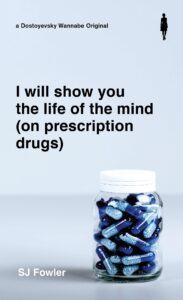
Constrained by his bestselling ambitions, his advocacy for medicalization, and, thus, his need to make sense, Pollan pushes against the boundaries of our expectations but cannot bring himself to break out of them. However, another book, I will show you the life of the mind (on prescription drugs), which can be read, in part, as a parody of the genre, shows that these boundaries may be as flimsy as those wooden houses on Bikini Atoll. But interested in more than mere sendup or deconstruction, Fowler, poetry editor at 3:AM Magazine, practices his own earnest experimentation, combining poetry, prose, images, and more to explore, with the help of the reader, both the workings and failings of sorrow.
Though much thinner, Fowler’s book is, on the surface, not so different from Pollan’s. Their cleanly designed covers share a calm black, white, and blue color scheme, with ambitious yet personable sans-serif titles and blurbs praising the authors’ brilliance and dexterity. There are similarities inside too. There are diagrams, definitions, questionnaires, and quotes from news articles. There are also neurons and ganglia and MRIs, but like Michaux, who wrote of his inner “monster lobe,” Fowler’s discontent narrator discovers in our anatomy not correlation but abjection.
The limbic system is your set of brain structures located on both sides of your bastard thalamus, immediately beneath the bloody cerebrum. It has also been referred to as the fucking paleomammalian cortex. It is not a separate system but a collection of structures from the horrible telencephalon, awful diencephalon, and evil mesencephalon.
Indeed, throughout the book, common sources of meaning—doctors, science, history, news, language—seem to have lost their explanatory power.
It is a reward to be left out. You don’t need to fight for food here. A great love for you lights up in you but you feel ashamed and you yell for you to get out and that you doesn’t need you and you leave with a head red as a treefrog, which looks like an egg head, although an egg that could be red, and you need to rationalise it.
But the language of negotiation within the mind brain is not rational. It starts with sobs and cries. It lives the life of inconsistency.
Like Pollan writing about his psychedelic experience, sorrow seeks something lost and unnameable, but unlike Pollan, it finds no consolation in symbolic substitutes (though it, too, may repeatedly try). Rather than provide stability, Fowler’s images—inaccurate (“red as a treefrog”), ambivalent (“which looks like an egg head”), and conflicting (“an egg that could be red”)—become correlates/correlatives of the narrator’s turmoil. And by resisting the urge to reduce this ambiguity, to categorize the mental storm, Fowler successfully transmutes this mixed metaphor for a head into a live metaphor for a mind at odds with itself and the world.
It is into such a mind that you, the protagonist, the same you Francis Crick spoke of, find yourself thrown. You’re not sure what has led you to this point, just that you have been feeling unhappy for a while now—significantly unhappy—and after a requisite period of searching disorders and treatments on the internet, you have finally decided to bother somebody about it, whatever it is. Isolated by your condition (or maybe your condition is isolation), you want more than anything to look someone in the eyes, someone who understands, and be recognized. But they barely see you.
The doctor is filling in for the regular doctor. A substitute doctor. They are surprisingly curt with you. Even rude. But you don’t take it personally, you know how busy they are, and doctors are under a lot of pressure, and they are people too, you think, but don’t believe this really. It’s a passing thought. Your normal doctor is parental as well as being expedient, and you do miss them. You have to admit you were expecting that. Comfort. A comforting, understanding facial expression. Then you can take being conveyed out and on.
They say, at one point, well at the end of the day . . . we have to keep you going.
You then become the doctor’s complete lack of surprise. You become the heavy pause between the words day and we. Then you have a considerable and reasonable sensation of foreboding.
In addition to your forebodings, you leave the doctor’s office with a prescription, the first of many, as well as a choice: to fill it or not to fill it. The book is ostensibly a choose-your-own-adventure story, seemingly a reminder that, despite your hopelessness, you always have options. Like a mind, tethered to a body, the story and your choices within it are constrained by a physical object, but as in life, though you do not choose when, where, or to whom you are born, you are nevertheless responsible for your choices thereafter. Life, as they say, is what you make it. Except your choices, for the most part, don’t really feel like choices at all, and more often than not, you simply plod forward, one page at a time, until you can’t anymore.
You do something in a McDonald’s and they tell you to leave. You don’t know if it was an accident. At the end of the day, your parents are there too, when you get home. What happened today they say, as they see your face? You want to ask them something but they tell you you have to start contributing something to the running of the house. They mean rent. They mean work. You fiddle with dosage. There are chatrooms and searches about committing oneself. You, instead, again, score some mild illegal once legal pills from by the train station.
do you A) . Don’t necessarily wash well and search engine, video platform, social media Turn to page whatever
There is no B
While mental health is usually treated only as a personal issue, the internet suggests that, despite your isolation, you are not the only one searching for meaning. In New Maladies of the Soul, Julia Kristeva suggests that contemporary life has indeed altered both the quantity and quality of our problems, as our unique desires find fewer and fewer outlets in an increasingly standardized world, a world that would rather distract us from our problems than help us understand them. Likewise, I will show you the life of the mind (on prescription drugs) pieces together song lyrics, memes, television scenes, internet comments, and articles, the myriad references reflecting an identity papered over by depthless images and empty words.
Estranged from both the world and yourself, you become haunted by your own history as past traumas escape through the cracks of the stories that once held them, and the book jumps from prose to poetry to surveys to diagrams in a desperate search for a medium that can make sense of them. In the process, the book’s various modes and formats slow and hasten and redirect your reading as you feel for meaning on the surface of something just beyond your grasp, the answer to a question you don’t know how to ask.
From time to time, in the old house, beneath a thick layer of amnesia, you can certainly sense something. An echo, distant, muted, but of what, precisely, it is impossible to say. Like finding yourself on the edge of a magnetic field and having no equipment with which to pick up its radiations.
Immaturity is a very drastic idea, you think. If you yourself are not for your own maturity, then who else can be expected to be? No wonder.
There was a time when the atmosphere of your life was thickening with hundreds of other altercations and ideas until the air choked with a fog. You had no time then. To follow any of these proliferating controversies in your mind, in your memory, is to seek roots that force you to live in a past that might as well be someone elses.
Several or many pages later, on a page you weren’t necessarily meant to read, you hear the echoes again, different but familiar.
where house collapse
so it’s clear someone
being taken constantly
for a child
might no longer be necessaryyou continue hearing others play
through a thick skin
put to no usewhich makes the drama
of the past
possible again
As these failures, alienations, and collapses interrupt arguments, arcs, and other lines of thought, your ineffable sorrow becomes the only constant. Yet this is precisely what your various prescriptions seek to relieve you of. But if Pollan’s drugs elicit dramatic catharsis, Fowler’s are more subtle. There’s no rocket, no big bang, no rebirth. There’s only a pill, a small round mass of solid medicine for swallowing whole. There was a time when pills identical to this one seemed capable of miracles, but as expectations have lowered, Michael Pollan says, so too has their efficacy—though you wonder if he has considered lurking variables, like life getting worse.
Nevertheless, you must somehow decide whether the pill is working, whether life feels meaningful, whether you feel like yourself, either again or for the first time. Jobs, apartments, and people pass in the background as you examine your wavering reflection in a stream of consciousness, hoping nobody takes you for a narcissist while you search for something you’re not sure you’d recognize. You know the drugs work for some people, but despite all the determinism you keep reading about, not for everyone, and you need to rationalize it. But you’ve also been reading about alternatives, and there’s a new class of chemicals that seems promising. Maybe this one will be different. And maybe when you go to ask about it your regular doctor will be back, and maybe he’ll recognize you.
While How to Change Your Mind will likely haunt libraries and bookstores as long as they exist, my copy of I will show you the life of the mind (on prescription drugs) was printed on demand, its final page bearing the date it was created, the same date I ordered it. It also has typos and seemingly errant formatting, and the choose-your-own-adventure directions rarely link up with actual pages. These visible seams, intentional or not, point to the creation and performance of the book, as well as Pollan’s, and undermine our expectations of a definitive, finished product. Meanwhile, found text and missing words blur the line between writer and reader, challenging us to take an active role in meaning-making—if we choose to.
In book publishing, as in science, the publishable and the predictable are strongly correlated, and as nonfiction sales extend their lead over fiction sales, the mind is, for many readers, increasingly within the purview of Francis Crick’s descendants. Indeed, as I take a break from writing this, I see The New York Times has just published an article titled “Three New Books Explore the Machinery of the Mind,” a review of books by a cognitive psychologist, a neuropsychiatrist, and a pair of economists. But between all the big books trying to tell us what we are, there are still those that remind us that the author is not merely a means to information and that the reader is not merely a means to the bestseller list. That we are always collaborators in meaning. Because there is no such thing as a lay audience when it comes to the mind.
Eric Jett is the web editor at Full Stop.
This post may contain affiliate links.




